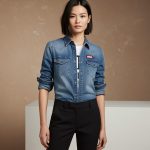Overview of Sustainable Fashion Blogging
In recent years, sustainable fashion blogging has seen a significant rise, weaving eco-consciousness into the fabric of UK fashion trends. As climate awareness grows, the importance of sustainability in the fashion industry intensifies, creating a fertile ground for bloggers committed to environmental causes.
The UK’s fashion scene has embraced this shift, with trends gravitating towards eco-friendly materials and ethical production practices. Brands are increasingly focusing on transparency, and bloggers serve as vital channels for communicating these values to a wider audience.
Also to see : Unlock the Perfect Nude Lipstick: A Guide to Finding Your Ideal Shade for Every Skin Tone
Blogging about sustainable fashion offers numerous benefits, not just for the environment but also in cultivating a dedicated community. By spotlighting sustainable trends, bloggers can influence consumer behaviour and promote informed purchasing decisions. Moreover, their platforms become a meeting ground for like-minded individuals eager to adopt a more environmentally responsible lifestyle.
In the intricate web of sustainable fashion blogging, the goal is to educate, inspire, and lead by example. Bloggers play a pivotal role in this ecosystem by showcasing sustainable choices that seamlessly blend style with ethics. As a result, readers are encouraged to rethink their fashion habits and opt for a more eco-conscious wardrobe.
Also read : Top Hair Styling Products for Defending Your Curls Against the UK”s Humid Weather
Eco-Conscious Strategies for Content Creation
Crafting content that resonates requires a thoughtful approach. Sustainable blogging tips can guide creators towards impactful storytelling while ensuring their eco-friendly efforts shine through.
Utilizing Sustainable Materials
Incorporate eco-friendly content by sourcing materials that showcase sustainability’s role. From textiles to packaging, emphasising products made from recycled or organic resources offers your audience a deeper connection to your message. Highlight materials that reduce environmental footprint, like plant-based dyes or biodegradable assets, to enhance responsibility in content creation.
Showcasing Ethical Brands
Aligning your blog with ethical brands is pivotal. These partnerships shed light on companies prioritising fair labour, ecological responsibility, and transparency. Feature brands holding certifications like Fair Trade and GOTS, demonstrating authenticity and commitment to sustainable practices. These collaborations help readers trust your recommendations, knowing they’re rooted in ethical integrity.
Creating Engaging Visual Content
Visual storytelling is key to captivating audiences. Employ vibrant imagery and compositions that reflect sustainable practices and values. Consider using photo essays or behind-the-scenes looks at eco-conscious manufacturing processes. Tools like infographics make complex data digestible, educating your readers while maintaining aesthetic appeal.
Overall, these strategies enhance sustainable fashion blogging, enriching content with genuine eco-friendly messaging.
Building an Audience Focused on Sustainability
In the realm of sustainable fashion blogging, capturing the attention of an eco-conscious audience is crucial. Understanding your target readers is the first step. Identifying individuals keen on ethical fashion choices enables you to tailor content that deeply resonates with their values.
To foster longevity in reader relationships, engaging personal stories and experiences can act as powerful connectors. Sharing your journey in embracing eco-friendly habits not only personalises your narrative but establishes common ground with your audience. This level of engagement transforms passive readers into an active, supportive community.
Interactive content plays a pivotal role in audience engagement. Encourage your audience to participate by inviting opinions, questions, or content suggestions, directly involving them in your blogging process. Features like polls, Q&A sessions, and eco-fashion challenges welcome readers to contribute their insights, thereby deepening their connection with your blog.
Maintaining a thriving community hinges on your ability to build authentic relationships with your readers. By focusing on genuine communication and leveraging interactive content, your platform not only thrives in engagement but stands as a beacon for eco-conscious living. As your audience becomes invested in your sustainable journey, they are likely to become champions of your message.
SEO Strategies for Sustainable Fashion Blogs
In the world of sustainable fashion blogging, effective SEO strategies are essential for enhancing visibility and driving organic reach. By focusing on sustainable keywords, bloggers can tailor their content to align with eco-conscious search queries, thereby increasing their presence online.
Keyword Research for Eco-Fashion
Thorough keyword research is a cornerstone of SEO success. Identifying terms such as “eco-friendly fashion” and “sustainable wardrobe” helps attract targeted visitors who share these values. Utilizing tools like Google Keyword Planner can assist bloggers in uncovering high-volume keywords that resonate with their audience.
On-Page SEO Practices
Implementing on-page SEO techniques is crucial. Optimising title tags, meta descriptions, and header tags with sustainable keywords ensures that blog posts are easily discoverable. Including relevant alt text for images and maintaining clean, engaging URL structures further boosts search engine performance.
Building Backlinks with Ethical Brands
Partnering with ethical brands not only reinforces eco-friendly commitments but also enhances SEO through backlink building. Establishing collaborations with like-minded companies can lead to valuable backlinks, demonstrating your site’s authority and relevance in the sustainable fashion space. Such partnerships benefit both bloggers and brands, elevating their online profiles while fostering a network of sustainability advocates.
Monetization Methods for Sustainable Fashion Bloggers
In the burgeoning field of sustainable fashion blogging, understanding effective monetization strategies is pivotal for bloggers seeking financial viability while maintaining their eco-friendly ethos. Partnering with sustainable brands through affiliate marketing is a favourable option, allowing bloggers to earn commissions by recommending products that align with eco-conscious values. This requires selecting brands whose ethics resonate with the blog’s vision, ensuring authenticity and relevance for both the audience and the brand.
Creating sponsored content presents another valuable avenue. Bloggers can work with eco-friendly brands to produce content that highlights the sustainable features of a product, fostering a mutually beneficial relationship. However, authenticity is crucial; blogging should reflect genuine use or admiration of the product to avoid alienating readers.
Additionally, offering unique products, such as e-books on sustainable fashion tips or hosting paid webinars, can diversify income streams. These strategies allow bloggers to monetise their expertise and offer added value to their audience. Engaging with a network that prioritises sustainable practices not only broadens monetization opportunities but also reinforces the blogger’s commitment to environmental responsibility, thus attracting a dedicated and engaged reader community.
Case Studies: Successful Sustainable Fashion Bloggers in the UK
Delving into case studies offers a glimpse into the successes of successful bloggers who have made a mark in the realm of sustainable fashion in the UK. These insights can serve as a source of inspiration for those aspiring to tread the eco-friendly path.
Spotlight on Influential UK Bloggers
One notable name in this sphere is Lucy Siegle, whose journalism background bolsters her authority in the sustainable fashion blogging community. Similarly, Aja Barber stands out for her dedication to advocating against fast fashion, blending her ethics with style seamlessly. Their influence lies in how they communicate eco-conscious values effectively while maintaining a distinct voice.
Lessons Learned from their Success
A key takeaway from these bloggers is the importance of integrating passion with purpose. Consistently aligning content with genuine environmental concerns builds credibility. Additionally, engaging storytelling coupled with transparency helps in crafting relatable narratives.
Strategies Employed for Growth
Successful bloggers often employ strategies like leveraging social media channels to reach broader audiences. They also foster community building by actively responding to reader feedback and cultivating dialogue. Their growth is marked by strategic collaborations with brands sharing aligned ethical values, further amplifying their reach and reinforcing their commitment to sustainability.
Maintaining Authenticity and Transparency
In sustainable fashion blogging, authenticity in blogging is paramount. Being genuine not only reinforces credibility but fosters trust with your audience. It’s essential to portray your true experiences and viewpoints, steering clear of exaggerations or half-truths. This sincerity paves the way for building a lasting and trusted bond with readers.
Transparency plays a crucial role in trust building. Consumers are increasingly inquisitive about the sustainability credentials of products. By openly sharing both the challenges and successes encountered in your sustainability journey, readers are offered a realistic perspective that resonates with their own experiences. This honesty enhances your blog’s credibility and cultivates an environment where dialogue thrives.
To effectively maintain transparency, outline your sustainability efforts clearly. Provide insights into the materials, brands, and practices you support. Disclose partnerships and sponsored content in unambiguous terms, ensuring your readers are well-informed.
A strong emphasis on authenticity and transparency not only fortifies the relationship with your audience but also positions your platform as a trustworthy source in the sustainable fashion domain. By diligently sharing genuine content, you empower your readers to make informed decisions and support the broader movement toward eco-conscious living.










